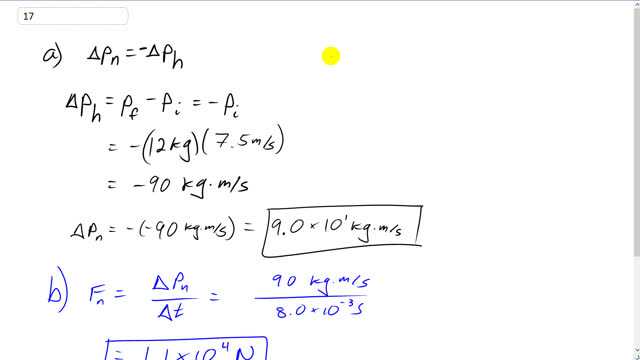
A 12-kg hammer strikes a nail at a velocity of 7.5 m/s and comes to rest in a time interval of 8.0 ms.
- What is the impulse given to the nail?
- What is the average force acting on the nail?

In order to watch this solution you need to have a subscription.
This is Giancoli Answers with Mr. Dychko. The impulse given to the nail is on the opposite direction but equal magnitude to the impulse given to the hammer; you can think of it as, you know, a Newton's third law type of concept there, you can say that the impulse on the nail is the force on the nail times the time during which the force is applied and that's a force on the nail due to the hammer and well because these two forces are Newton's third law pairs— the force on the nail due to the hammer versus the force on the hammer due to the nail— this must be true by Newton's third law and this one is the impulse on the nail and this thing here without the negative sign is the impulse on the hammer and so this equation is saying that they are equal with a negative sign in front as I have shown here. So let's plug in some numbers and get an answer. Well, we know that the impulse on the hammer is its final momentum minus its initial momentum but it has no final momentum because it comes to rest and so the impulse on the hammer is the negative of the initial momentum. And so that's 12 kilograms times 7.5 meters per second, negative, and just to be clear there's two significant figures, we'll write it in scientific notation by saying 9.0 times 10 to the 1 kilogram meter per second is the impulse on the nail; it's the negative of the impulse on the hammer so it's positive in this case in the end. The force on the nail is gonna be its impulse divided by the time during which the force is applied so that's 90 kilograms meters per second divided by 8 milliseconds which is 1.1 times 10 to the 4 newtons.
why isn't the impulse -90 kg x m/s instead?
I don't understand why the answer is positive...